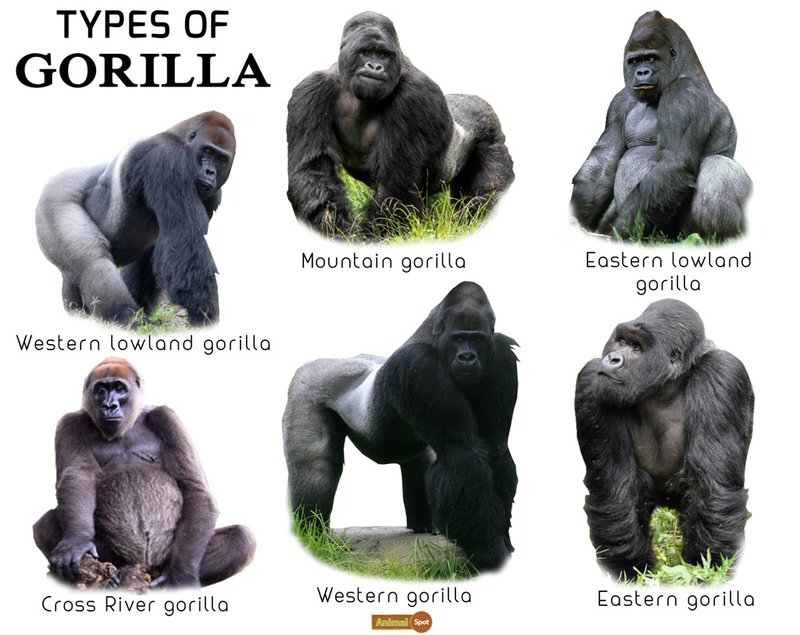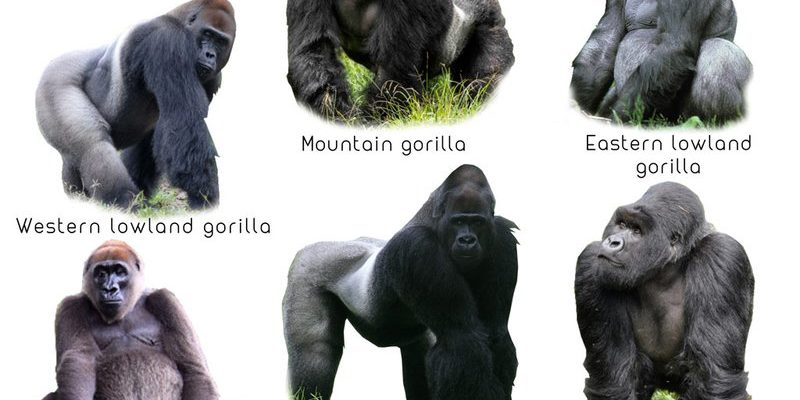
Just like how two people can have similar hair or eye color yet still have their unique traits, many animals share characteristics with the Eastern Gorilla. This can be due to their environment, diet, or even social structures. In this article, we’ll dive into ten animals that resemble the Eastern Gorilla and explore how to tell them apart. It’s like comparing apples to oranges—both interesting, but definitely distinct.
1. Western Gorilla
The Western Gorilla is the Eastern Gorilla’s closest relative. While they may look quite similar at first glance, there are key differences to notice. The Western Gorilla is typically smaller, weighing around 300 pounds compared to the Eastern Gorilla’s average of 400 pounds. They have a more slender build, which makes them appear less robust.
Another striking difference is their fur color. Western Gorillas have a lighter, grayish-brown coat compared to the darker, almost black fur of their Eastern counterparts. Socially, they tend to form smaller groups, often with fewer males than the Eastern Gorilla. This leads to unique behaviors and social interactions, shaping how they live in the rich biodiversity of their habitats.
2. Chimpanzee
You might find yourself surprised to see a Chimpanzee on this list. While they’re not as large as Eastern Gorillas, they share some similar features. These primates are highly intelligent and show great social behavior, just like gorillas. However, the biggest difference lies in their size and shape. Chimpanzees are much smaller, weighing around 100 pounds, and have a more agile and flexible body built for climbing.
Additionally, Chimpanzees possess longer limbs, which they use for swinging through trees. Their faces are also more expressive, giving them a distinctly different appearance compared to the more stoic expression of Eastern Gorillas. Despite their differences, the bond within Chimpanzee troops can be heartwarming to witness, showcasing the complexity of primate relationships.
3. Orangutan
Next up is the Orangutan, often found in the rainforests of Indonesia and Malaysia. Like the Eastern Gorilla, they share a vegetarian diet, munching on fruits and leaves. One of the most noticeable differences is their bright orange fur, setting them apart from the darker fur of gorillas.
Orangutans are also known for their solitary nature; whereas Eastern Gorillas thrive in social groups, Orangutans usually spend a lot of time alone, only coming together to mate. They have long arms that help them swing between trees, making them proficient climbers. Understanding these differences provides insight into their adaptations to different environments.
4. Bornean Gorilla
Though the Bornean Gorilla may sound like a distant cousin, there’s a compelling argument for its inclusion here. Often confused with the Western Gorilla, they are actually a subspecies with distinct traits. In terms of physical features, Borneans are generally shorter and stockier than Eastern Gorillas. One key identifier is their wider face structure—a result of their diverse diet that includes tougher vegetation.
Behaviorally, Borneans exhibit differences in their social structures as well. They are typically more assertive in establishing dominance hierarchies compared to their Eastern counterparts. Observing these nuances helps paint a fuller picture of the world we share with these incredible animals.
5. Mandrill
The Mandrill may be strikingly different in appearance but still shares some similarities with the Eastern Gorilla in the primate family. Known for their vibrant facial colors and unique markings, mandrills are smaller and more colorful than gorillas. These features come from living in dense forests where they can camouflage effectively.
Unlike gorillas, Mandrills are much more social and live in larger groups, sometimes numbering over a hundred. Their hierarchies are highly complex, with males using their bright colors to assert dominance. While they may not share the same habitat, understanding their social structures can give insight into the evolutionary adaptations of primates.
6. Bonobo
Another fascinating primate is the Bonobo, often mistaken for Chimpanzees. These creatures, while smaller than Eastern Gorillas, share some striking similarities in their social behavior. Bonobos tend to be matriarchal, meaning females lead their groups, in contrast to the male-dominated structures of Eastern Gorillas.
Despite being smaller in size, Bonobos have a remarkably similar facial structure to gorillas, which can cause initial confusion. Their playful nature often includes a variety of social interactions, showcasing emotional depth that’s captivating to observe. Learning about Bonobos helps us understand the diversity of primate behavior, which can mitigate our own assumptions about gorillas.
7. Sumatran Orangutan
Similar to the Bornean Orangutan, the Sumatran Orangutan adds another layer to the relationship between these incredible primates and the Eastern Gorilla. While the Sumatran variety is also characterized by striking orange fur, they are smaller and have a more slender build. They rely heavily on tree-dwelling habitats in their native Sumatran forests.
In terms of behavior, Sumatran Orangutans are much more social than their Bornean relatives, sometimes forming small groups—but they are still less social than Eastern Gorillas. Their diets tend to focus more on fruits available in the treetops, showcasing adaptation to their specific habitats.
8. Red Panda
You might be scratching your head, wondering how a Red Panda fits in here—but bear with me! Although they’re not closely related to gorillas, they share habitats in forested areas and have some similar dietary preferences. Both animals are primarily herbivorous, and the Red Panda chooses bamboo as its staple food, much like some gorilla species enjoy leafy greens.
Physically, red pandas are much smaller, and their appearance is quite different, with their characteristic fluffy tails and markings. They’re solitary creatures, much like the gorilla’s more introverted side. Understanding the Red Panda’s lifestyle and diet helps broaden our appreciation for the various adaptive strategies animals have developed.
9. Gibbon
Let’s talk about the Gibbon, a smaller primate known for its incredible agility. While they share some characteristics with the Eastern Gorilla, like their tree-dwelling nature, Gibbons are much lighter and known for their swinging movement through the forest canopy. Their long arms help them navigate trees with ease—something that gorillas, who are more terrestrial, don’t do as often.
One of the most charming aspects of Gibbons is their vocalization. They communicate through lovely calls, often heard echoing through the forests. In comparison, gorillas are mostly quiet, relying on body language and subtle gestures. Observing these differences gives us a better grasp of the diverse communication methods in the animal kingdom.
10. Siamang
Finally, we have the Siamang, another member of the gibbon family that shares some traits with Eastern Gorillas. Like Gibbons, Siamangs are tree-dwelling and boast long limbs for swinging, but they are larger and have a distinctive throat pouch that helps amplify their calls. Siamangs are known for their songs, often heard in the mornings, which resonate through their forest homes.
Despite their vocal similarities, Siamangs are more social, often found in family groups. This contrasts with the Eastern Gorilla’s sometimes more solitary behavior. Learning about their differences and shared characteristics helps us understand the many paths of evolution and adaptation in primates.
In conclusion, understanding animals similar to the Eastern Gorilla gives us insight into the fascinating world of wildlife. Each species has unique traits that make them special, whether it’s their physical attributes or social structures. By recognizing these differences, we can appreciate the rich biodiversity of our planet and the important roles each species plays in their ecosystems. So, next time you find yourself in the wild, take a moment to observe and learn about your animal neighbors; they may surprise you!

